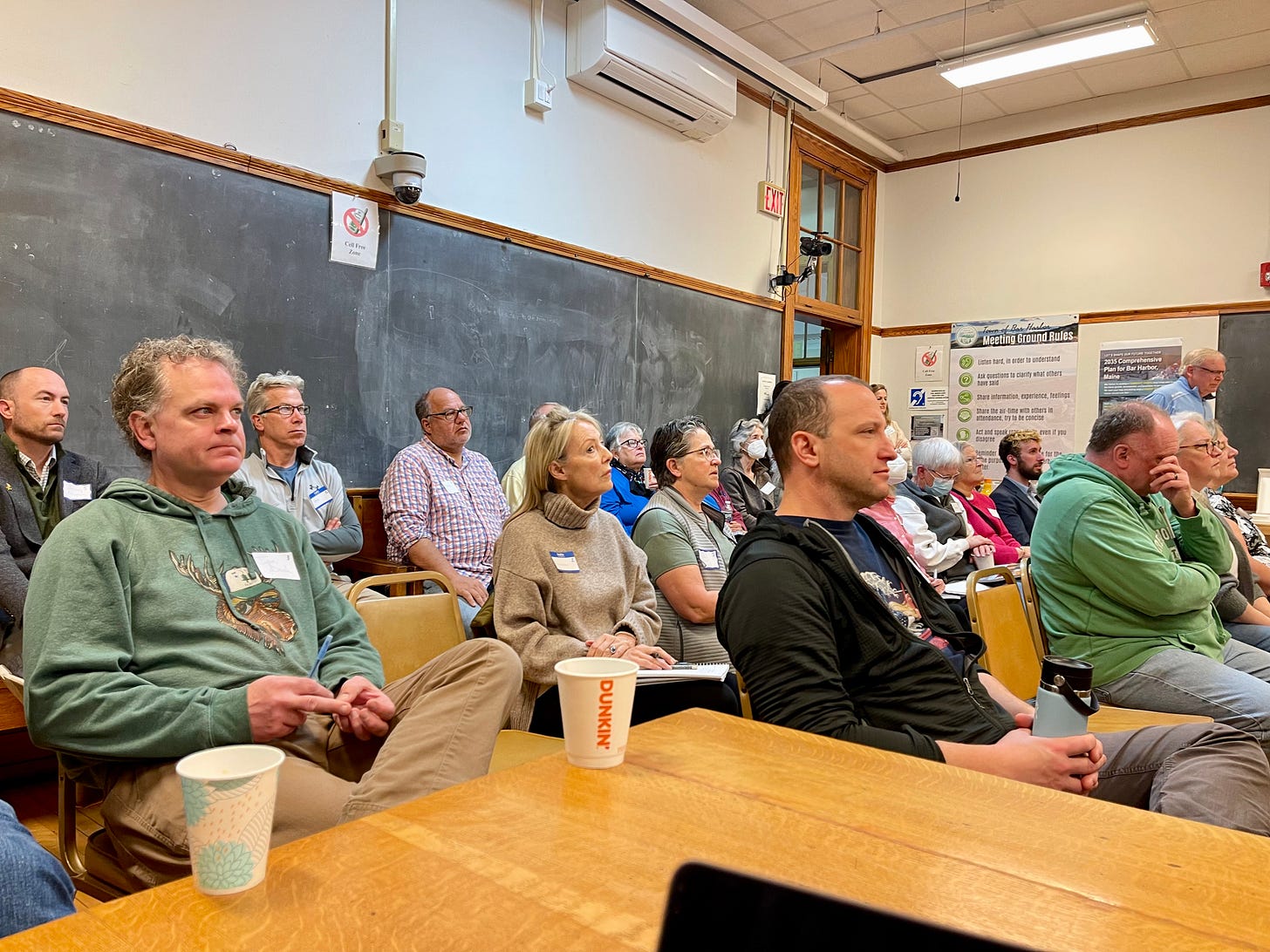Different Meetings, Different Perspectives
Comprehensive Plan Workshops Move Through Differences to Create Vision
BAR HARBOR—A bustling Atlantic Avenue Brewery played host to a comprehensive planning visioning session Tuesday night that attracted at least 50 people. It was the second in a series of four workshops that intended to help the town’s Comprehensive Planning Committee involve the public in the vision statement of the plan and receive feedback about future land use applications.
“There’s a lot of people here,” a woman murmured in a seat by the giant windows that let in the light from Cottage Street. “What a good thing.”
“It means people care,” the man next to her said.
“Exactly.”
The workshop earlier that morning at the MDI Biological Lab and the workshop Wednesday morning at the Bar Harbor Municipal Building drew similar crowds of multiple ages. All meetings, however, had slightly different concerns and gave voice to different groups of people.
The comprehensive plan is a broad policy document that sets the foundation for Bar Harbor’s land use regulations, and the last plan was adopted in 2007. This next plan is meant to span until 2035. There is meant to be synchronicity between the town’s land use ordinances and the insights and town goals outlined in a comprehensive plan. Basically, it’s meant to guide changes to a town’s land use ordinances.
Bar Harbor’s Planning Director Michele Gagnon told attendees at the workshops that there are three types of policies the plan drives: regulatory policies implemented through land use ordinance and zoning, non-regulatory policies, and fiscal policies.
Basically, the future land use map is the basis on which the town develops or redevelops its zoning. The Comprehensive Planning Committee has been focusing on a few major issues, especially affordable housing.
“The purpose is to look into the future and see what we want as a community,” Gagnon said at the Atlantic Brewing workshop.
The process usually takes 18-24 months, according to Steve Whitman of Resilience Planning (the company guiding the process for the town). He said that because Bar Harbor is making it as open to public involvement as possible and is having multiple check-ins with the community and is vetting the major components of it, it’s helped to extend the timeline.
Liz Kelly of Resilience Planning said that by having public workshops and input sessions, there’s a hope that it will make the plan feel familiar.
The forums are meant to give people a chance to work with other people in the community as well as receive feedback about some of the plans components and its draft vision statement.
MDI BIOLOGICAL LAB WORKSHOP AND WATER WORRIES
At the MDI Biological Laboratory Tuesday morning, a lot of the feedback included infrastructure needs for development and Town Hill, Salisbury Cove, and Hadley Point area residents’ concerns over water use in that area, with particular concerns over wells running dry.
The discussion stemmed from two maps that showed potential development areas. The first map focused on Bar Harbor proper, Hulls Cove, and Town Hill as centers of development. The focus of expanding development was in downtown proper.
The second map was similar, but included Hadley point and Salisbury Cove as areas where residential development could occur in addition to downtown Bar Harbor, Hulls Cove and Town Hill.
BAR HARBOR BUSINESS SESSION
At the session at the Bar Harbor Municipal Building on Wednesday morning, there was an invitation to business representatives and others to be heard in the process.
Donuts and coffee abounded as groups spread out across the top floor of the old school house. Throughout the two-hour workshop, a lot of the feedback was about simplifying the land use ordinance, creating development that doesn’t impact current residents in the neighborhoods, being mindful of infrastructure ahead of development, and creating cost-benefit analysis whenever things are implemented. It also mentioned blending vibrant businesses and neighborhoods in a cohesive way.
“Don’t mess up what makes Bar Harbor Bar Harbor,” one man said.
Those attending the Wednesday morning workshop also mentioned increasing the allowed lot density in downtown proper, increasing height allowed on residential buildings, minimizing lot size, and focusing on density of the downtown village. Retirement housing downtown was also a wish. Others discussed the water table in Town Hill, nitrogen loading in the water and making sure to put supporting infrastructure in future developed areas prior to opening the areas to development.
A discussion of housing was a driving issue at all the events. But there was also talk about safety, with one woman saying it was increasingly unsafe to bike and walk in the downtown village. There was also a discussion of gentle density or building in relationship to what the ground can bear, the tourism industry, and what it means to be “light commercial.” There wasn’t a tremendous amount of discussion about working waterfronts, education, or culture in the reporting of the groups.
Connections were made in the smaller groups even as people who are polarized on certain issues (like cruise ships) talked about Bar Harbor’s future and the action steps to get there.
ATLANTIC BREWING DISCUSSION
At the Cottage Street brewery and restaurant, people sat around tables and clustered in a cozy corner with couches for a spirited discussion of the town’s vision statements as well as broad land use and potential development.
Discussion about the vision statement included things like the need for an Oxford comma, as well as what “equity” and some other terms meant. The Oxford comma was also mentioned at the Wednesday morning session.
The vision originated from the outreach and drafts and input that the committee received and created as well as the 2007 vision statement. Resilience Planning then created the draft vision. At the last meeting there were some worries that the first version of the draft vision wasn’t inspiring enough. Jim Mahoney and Town Council Chair Val Peacock (who is running for reelection to Town Council) and an unnamed writer created a vision. They then thought about the impact of the verbs and adjectives being used.
The vision statement is meant to be aspirational and in the present tense, as if everyone was in the brewery in 2035 describing Bar Harbor.
Criticisms of the statement included that it was vague, that it needed more specificity. One group said, “It’s not bad; it’s just not saying very much.” Another said that it doesn’t speak to exactly who Bar Harbor is, the character of the community. At the MDI Biological Lab meeting it was mentioned that the vision statement didn’t sound like “Bar Harbor speak.”
“We have to do better than a 42 character or less mentality. It’s a great start, but it’s nowhere where it needs to be to be a statement,” one man said at Atlantic Brewery.
Others said that while they agreed with a lot of the vision statement, it didn’t feel aspirational enough or brave enough.
Before the discussion, people spoke of deadline dates, hard budgets, and making plans for the holiday weekend.
A “big issues” poster waited in the back. Big issues spoken about included: a labor shortage, not enough housing, limited land, cost associations with sprawling, impacts for tourism.
“Bar Harbor is a very complex town,” Whitman said, which caused a gentle murmuring in groups. Soon there was discussion about cruise shift debates, short-term rentals, and the complex zoning of the town.
“We need to not have a zone for every house,” one man said.
At the meeting, people like Eric Stiles of Friends of Acadia spoke of the need for different sectors (commercial, government, nonprofit, and individual) to work toward trying to deal with housing shortages. Others asked if the plan was looking toward increasing, decreasing or having a stagnant population. There were a few somewhat heated discussions about housing, hotels, and tourism.
When the groups reported out, however, there was a calmness that permeated the brewery. Idea after idea was brought forth, concern after concern over issue after issue. It was also mentioned at multiple meetings that part of the reason the state mandates comprehensive plans is to prevent developmental sprawl and to protect the rural character of Maine.
For many of those at the meetings, it became a moment to be heard, to think toward the future, and to create concrete thoughts to hope to create a town that works with their vision of it.
As Whitman said, “You’re going to have to work together to make any of this happen.”
And this week, for many of those involved, it seemed like collaborating toward a future might be a possibility.
LINKS TO LEARN MORE
State statutes about the comprehensive plan
Bar Harbor’s 2007 Comprehensive Plan
More about the Comprehensive Planning Committee
The town’s website dedicated to the Comprehensive Planning process
Many apologies, we intended to go to all four of the meetings, but had a minor child emergency (super minor, all is totally fine) for the Wednesday night meeting that kept us home. Basically, our kid needed us.
All photos: Carrie Jones
All images: Resilience Planning























